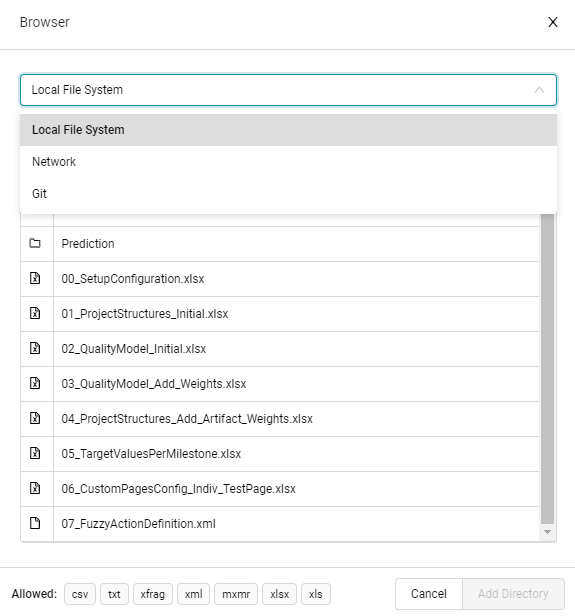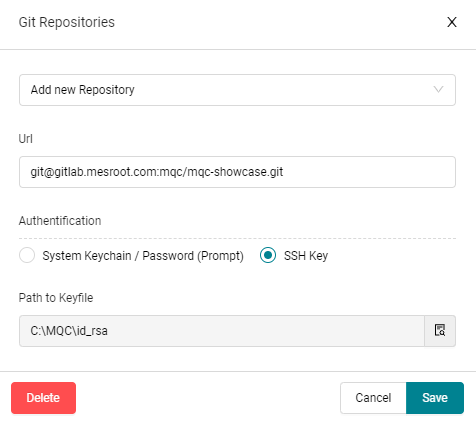7. Data Sources¶
To import data from reports in MQC, the data has to be provided as files. These files can be located in the local file system, a network path or a git repository.

Figure 7.1 Data sources in MQC. By clicking on “Add Data Source” a new data source can be configured.¶
A new data source can be added through a browser in the data source dialog. The type of the data source has to be selected first and then the respective directory, files or git repository can be added. You can also have multiple data sources added to your project.

Figure 7.2 The Browser to add a new Data Source¶
7.1. Local File System / Network¶
The local file system and network types function similarly. A directory, and therefore all subdirectories and files within, or a single file can be selected as the data source. At any point, the allowed file extensions that can be read by MQC are displayed below.
Navigating through the file system works like a windows explorer. Double-clicking a directory opens it. The current path is displayed at the top of the browser and can be used to navigate upwards in the file system. You can also add the path manually.

Figure 7.3 Local File System selected. Add/Edit the path manually.¶

Figure 7.4 Network selected. The path can be used to navigation upwards by click.¶
The local file system of the server is not accessible when using the web player.
7.2. Version Control Systems¶
MQC also allows version control systems to be used as a data source. Currently only Git is supported.
7.2.1. Git (Beta)¶
After selecting Git as the data source type, all previously configured git repositories in the project are available for selection.
By clicking on “Manage repositories” git repositories can be added and already configured repositories can be deleted or modified.
Note
If git is not installed, locally (if using the MQC desktop client) or on the server (if using the web player), an error is shown.
Git for windows can be found here: https://git-scm.com/downloads

Figure 7.5 Git selected. No repositories are configured yet.¶
Git repositories can be added by ssh or https urls.
An rsa private key can be provided for authentification of ssh urls if it is not configured as the default ssh key for the current user.
For an https url the authentification has to be done by entering the username and password, if it is not already stored in the windows credential store.
When a repository is saved, it is validated and all the available branches are fetched from the remote. If the authentification fails, a error message is shown.

Figure 7.6 Git Repositories dialog to add, delete and modify git repository configurations for data sources.¶
You can select a branch if atleast one git repository is configured.
To add a directory or a file from the git repository as a data source, the repositories have to be cloned first. Afterwards, the directory / file selection works like in the local file system and network types.

Figure 7.7 Git selected after a repository has been configured. The branch has been selected and the repository was cloned.¶
If a git data source has been added, the monitoring service checks every 10 seconds if a new commit is made on the remote.
Alternatively, any branch which is checked out can be manually updated using
the Update Repository Branch and the last update time stamp is displayed
next to it.
When data is refreshed, the latest commit is fetched. Currently only the data from the latest commit is imported by MQC.